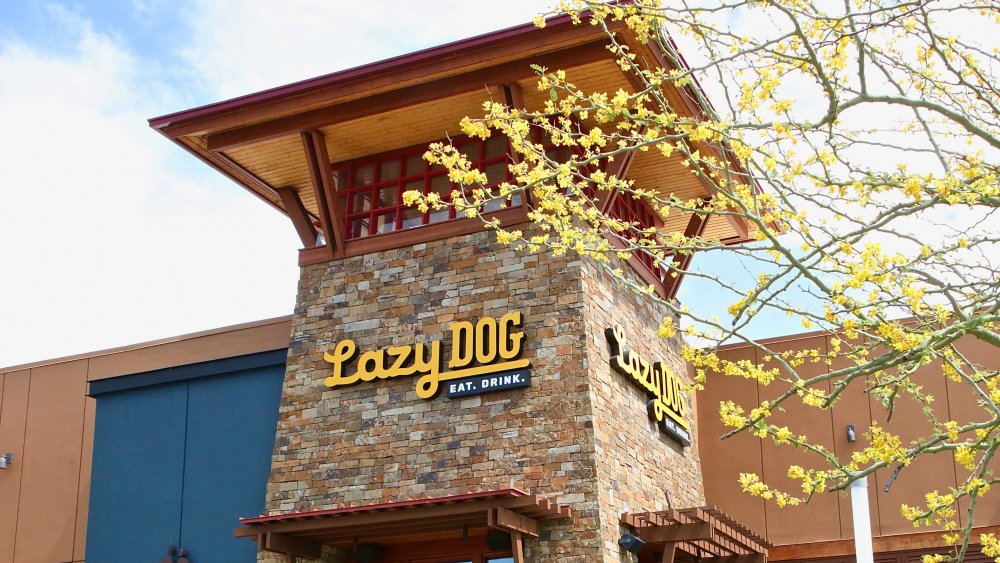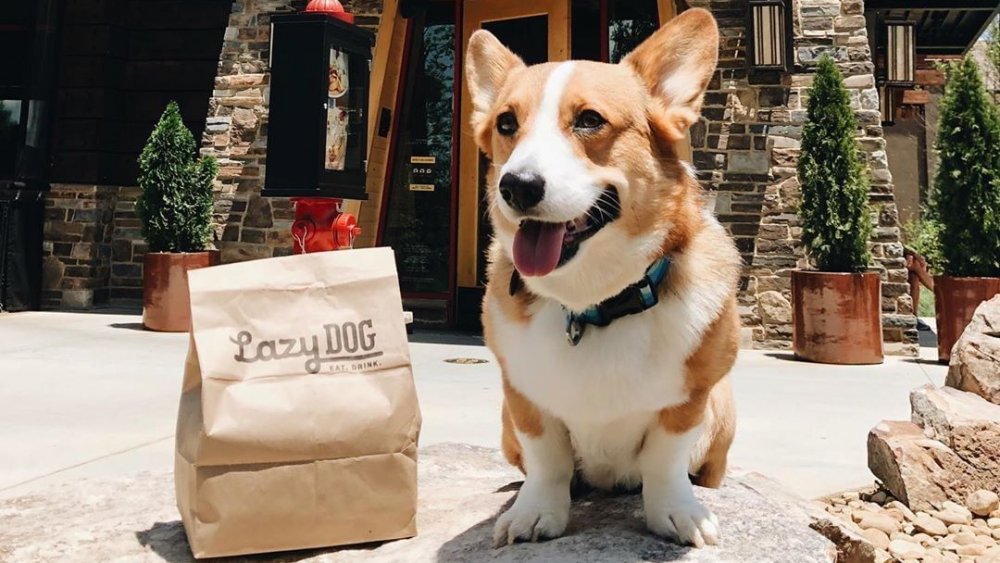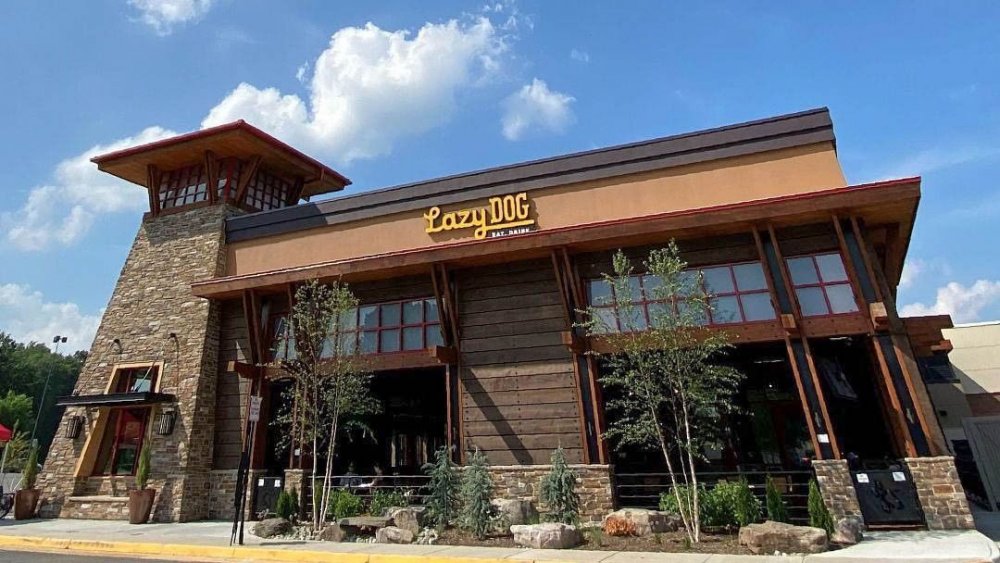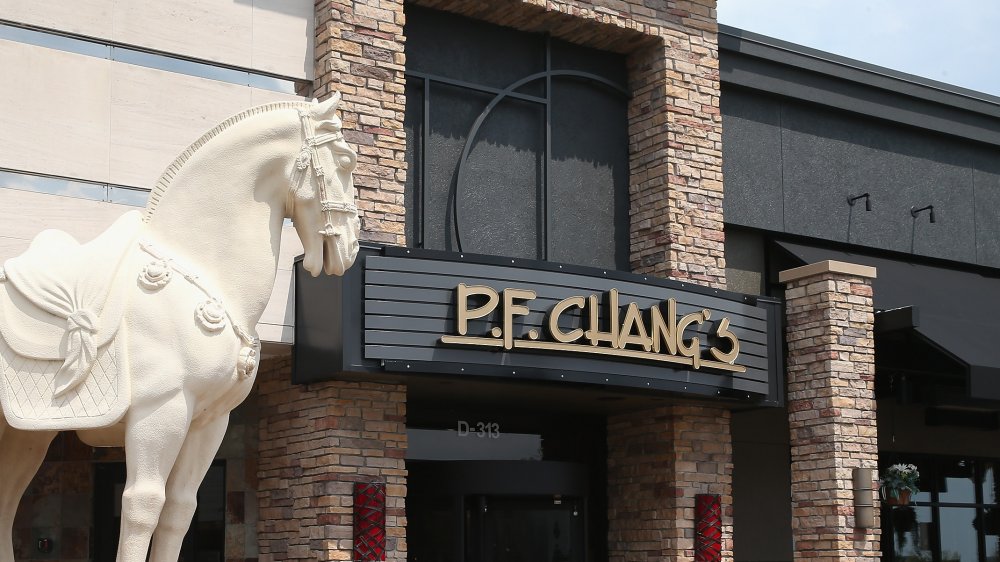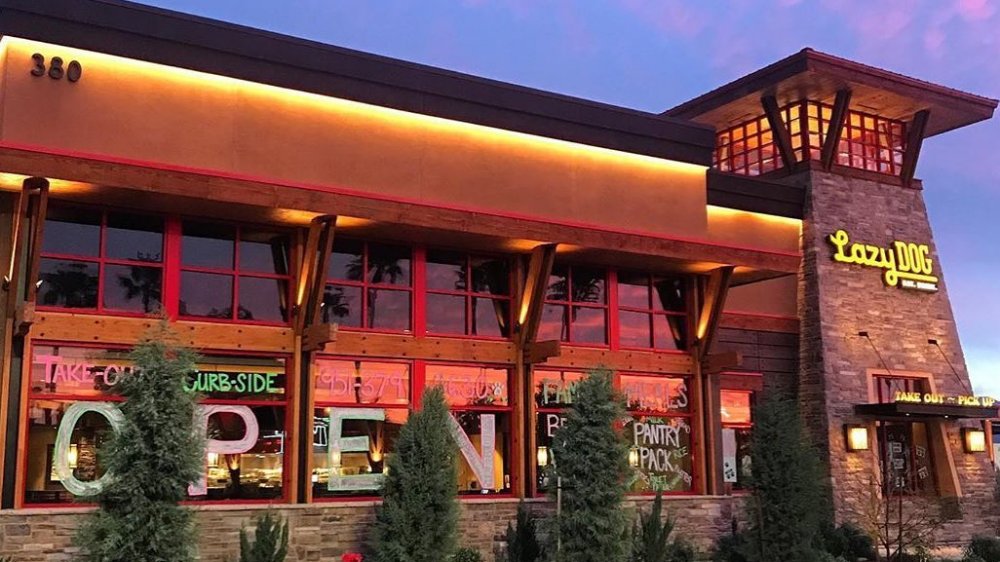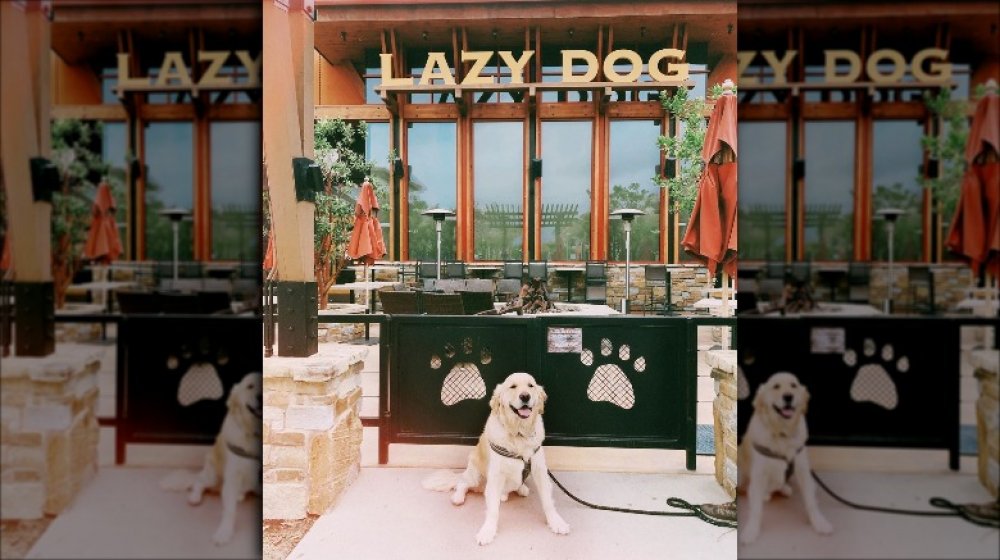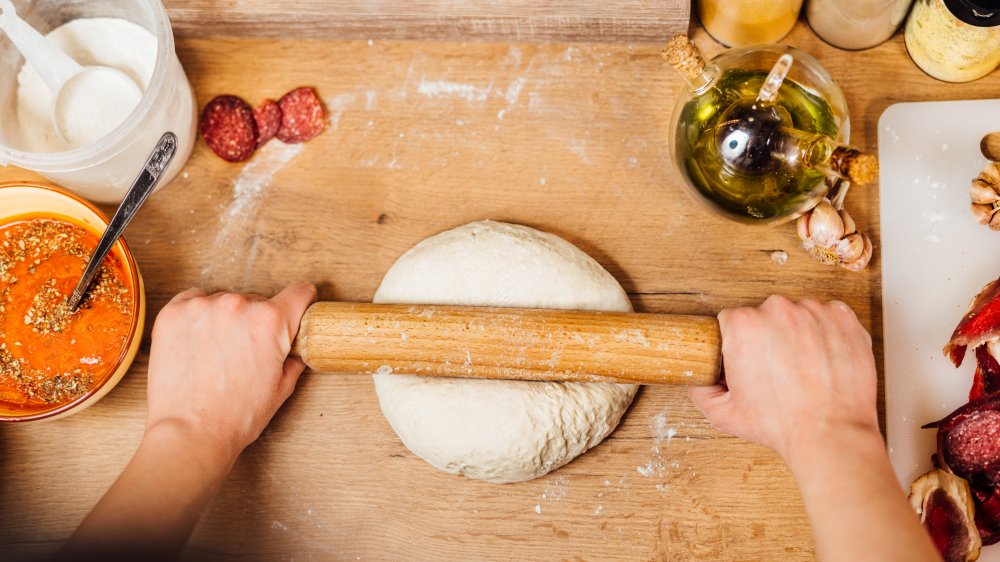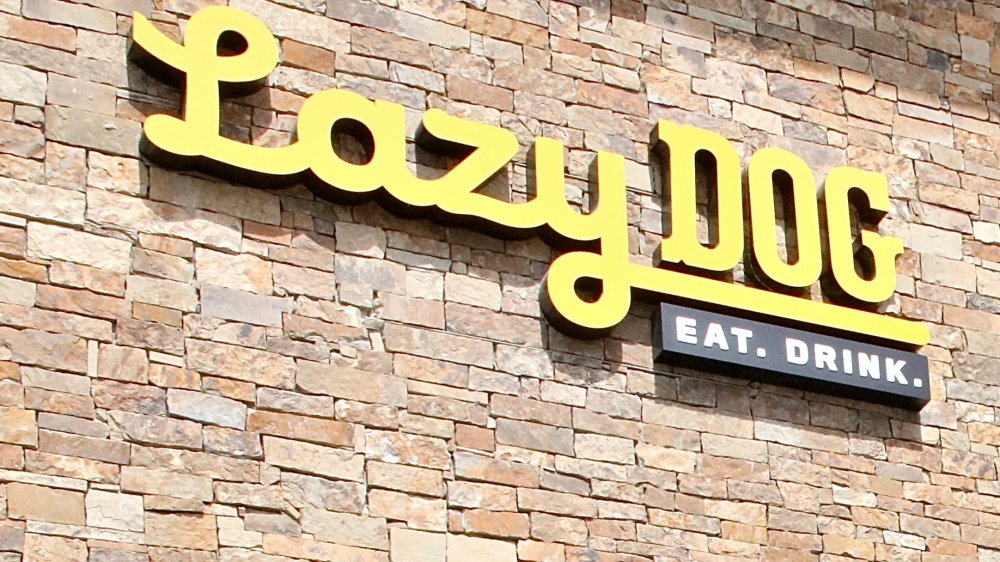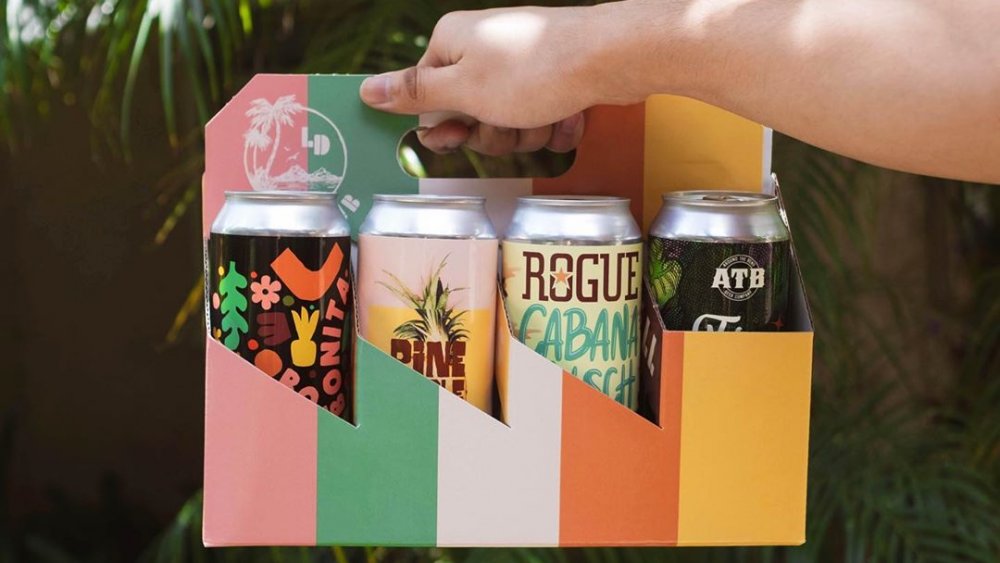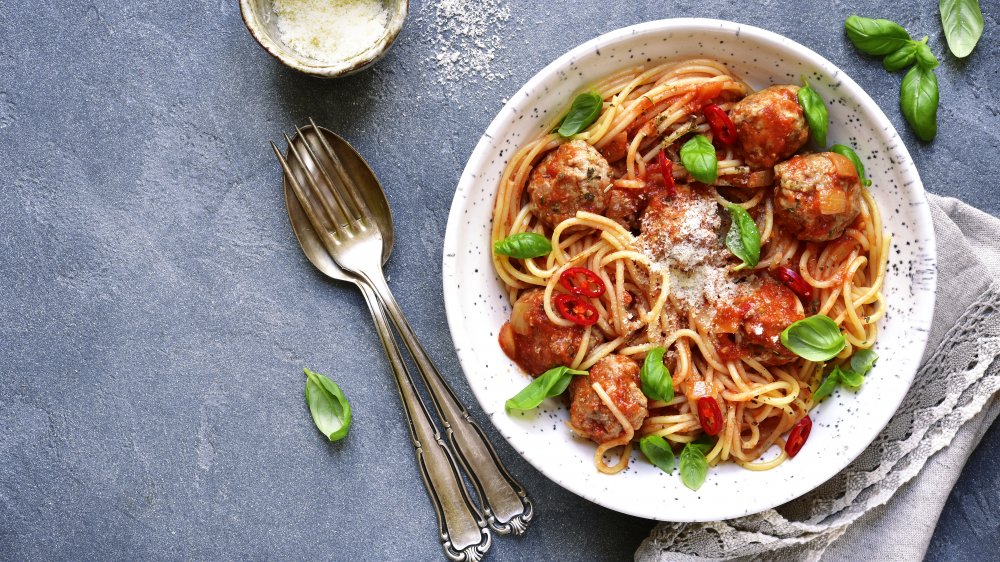Here's What You Need To Know About Lazy Dog Restaurant & Bar
Lazy Dog Restaurant & Bar is, as you might've guessed, a dog-friendly establishment. However, a closer look reveals that while Lazy Dog loves its furry friends, that's not the USP of the California-based restaurant chain. Much emphasis has been placed on creating a menu that's familiar and reminds one of comfort food, but also loaded with uncommon ingredients. Bee pollen, squash blossom, bison meat, anyone? According to Lazy Dog owner Chris Simms, his restaurants offer casual dining with "elevated comfort food."
As Simms revealed in an interview with TRA Marketplace, he founded the chain in 2003 after recognizing that most of the casual dining places that millennials went to were established by baby boomers. In an effort to change that, Simms launched his dog-friendly, kid-friendly, scratch-cooking eatery that partnered directly with farmers and ranchers to supply fresh food. In 2019, Nation's Restaurant News ranked Lazy Dog Restaurant & Bar one of the top ten fastest-growing chains. After a little digging, we know why. Here's everything you need to know about Lazy Dog Restaurant & Bar.
A real lazy dog inspired the restaurant and bar's name
In the early 2000s, Chris Simms and his father opened their first restaurant, which they named Lazy Dog Café (the name changed to Lazy Dog Bar & Restaurant in 2012). Simms came up with the "Lazy Dog" name when on a skiing trip in Jackson Hole, Wyoming. He had just returned to his lodge to find their family dog, a black Labrador retriever named Mattie, resting in front of the fireplace, the Los Angeles Times revealed.
At that point, he thought to himself, "I wish there was a place where everyone could enjoy life as much as that lazy dog," he recalled in an interview with the Chicago Tribune. At the 2019 Texas Restaurant Association (TRA) Marketplace, an annual restaurant and food service show, Simms said people initially thought the restaurant was anything from a pet supply store to a hot dog joint, but ultimately the name was a good fit.
While one might think that the idea behind calling the restaurant Lazy Dog was to highlight that it is a dog-friendly one, it was actually to appear "easy going and approachable", Simms explained. Otherwise, with a sophisticated menu, full bar, wide craft beer selection, and big windows like in a rocky mountain lodge, they were concerned that it would give an impression of a serious family restaurant, he added. Plus, the restaurant was eventually able to allow dogs onto their patio, feed them, and even start a dog club.
Lazy Dog Restaurant & Bar has a Rocky Mountain vibe
The interior of every Lazy Dog Restaurant & Bar was inspired by the Rocky Mountains, according to a press release on the company's website. The interior of the restaurants are spacious as are the patios — for the furry guests, of course.
"A lot of the architecture in this building is based on existing buildings in Jackson Hole, Wyoming," Sean Montes, Lazy Dog's regional culinary director, told the Gwinett Daily Post. Inside, there are fireplaces, ledge stone, and chandeliers crafted with Aspen logs that are reminiscent of the cozy mountain lodges. The decor reflects the roots of Wyoming rodeo culture, in particular. For example, at their Peachtree Corners, Georgia location, there is a painting of a cowboy riding a bronco. In line with the theme are sculptures of horse and deer heads, made with bits and pieces of metal, all done by artist Terry Jones. As Jones told Lazy Dog, he was first approached by founder Chris Simms in 2011 to make exclusive sculptures for the restaurant and has since made several — his favorite being a great dane sculpture.
You'll also find paw prints on the tables, dog-themed artworks on the walls, and television screens showcasing photos of pets uploaded by the visitors on the Lazy Dog Hall of Fame Photo Gallery — all of which bring in a fun element to the casual dining space.
P.F. Chang's had a role to play in the founding of Lazy Dog Restaurant & Bar
Lazy Dog Restaurant & Bar founder Chris Simms revealed to KFI AM 640 that he is "a fourth-generation restaurateur." His great-grandfather was in the restaurant business in Chicago, his grandfather was into the coffee shop business in Los Angeles, and his dad founded the Mimi's Cafe chain.
After graduating from Cornell University's hospitality school, Simms considered moving to New York for a job in finance, but switched gears to the restaurant biz. He decided he wanted to start his own restaurant, but he needed to get some experience first. Although he could've worked at Mimi's, he felt his "co-workers might be afraid to correct his mistakes," the Baltimore Sun explained. So instead, he went to work for P.F. Chang's.
During his experience managing the La Jolla, San Diego location of the chain, he learned several key lessons in managing a restaurant. When speaking with KFI AM 640, Simms recounted getting an offer from Paul Fleming, who developed P.F. Chang's, to be the first operating partner in a new venture (Pei Wei) in Scottsdale, Arizona. When Simms told his dad that they were willing to trust him with the brand new concept, his dad had replied, "Chris, if they are willing to do that, why aren't you willing to take the chance?" That's when Chris realized that he was ready to start his own restaurant concept.
This is how the first Lazy Dog Restaurant & Bar came to be
Chris Simms and his father, Thomas Simms, opened the first Lazy Dog Restaurant & Bar in Huntington Beach, California in 2003. Chris said in an interview with KFI AM 640 that it took $2 million to start the first restaurant. Armed with a business plan, he went to all of his friends and family for funds, raising $25,000 at a time.
"My dad was definitely a part of that and played such an important role in supporting me as I was building this business," Chris revealed. Just as they opened their fourth and fifth restaurants, the Great Recession struck. Chris recalled in the interview that they had already signed four leases and needed a whopping $12 million to build the restaurants. "The stock market has crashed ... . Everybody sold out, so now they've got all of this cash. We're the only investment they've got that is actually still returning money and still taking care of them," Chris continued. As a result, he was able to raise all $12 million during the recession.
Your pooches get their own menu at Lazy Dog Restaurant & Bar
In the patio space of Lazy Dog Restaurant & Bar, furry guests have their own menu. It includes, grilled chicken, brown rice, and grilled hamburger patties — all under $5, according to Thrillist. In late 2019, Lazy Dog also started a club for dogs called Pepper's Pack (named after founder Chris Simms' own dog, Pepper), whose members are eligible to get their meals for $2 (instead of the usual $5) and Play Packs that include two dog toys, two bags of treats, and one chew each quarter.
Simms told Restaurant Business that they are working on introducing dog beer, which is "basically an unfermented beer with nice sweet oats and barley." While the dog-friendly atmosphere is definitely a highlight, Simms hadn't started the restaurant with the plan for allowing dogs at all. He told the publication that it was pure luck.
It just so happened that on the first week of their operation, a woman came to the restaurant with her dog and asked if she could sit out on the patio. Coincidentally, people from the health department were also there for lunch. Simms simply went to them and asked if the woman could sit with her dog on the patio. Lazy Dog gradually became more and more dog-friendly, though Simms had to work it out with officials every step of the way.
Lazy Dog Restaurant & Bar's menu focuses on seasonal ingredients
The spring and fall menus at Lazy Dog look significantly different. In the spring, cocktails feature everything from fresh peaches to elderflower. Crushed sweet peaches are included in dishes such as burrata with roasted beet salad and in desserts, such as the peach raspberry hand pie. The spring menu also brings to table a generous amount of the in-season veggies. For example, their house-made veggie burger bowl includes avocado, baby kale, carrots and red peppers among other ingredients.
In the fall, you can order butternut squash soup, which is made with coconut cream and candied pumpkin seeds. Fall also brings with it sweet potatoes, brussels sprouts, and other seasonal vegetables. Oh, and don't forget about the pie that's made with wild huckleberries and cinnamon apples for dessert.
According to The Orange County Register, Lazy Dog changes its menu heavily twice a year, adding about 15 new items each time. The restaurant also introduces new dishes through the year, such as the "roasted winter veggies," which uses the juice of the popular winter fruit pomegranate, and vinegar as dressing.
Lazy Dog Restaurant & Bar makes almost all its food from scratch
Lazy Dog Restaurant & Bar takes pride in its nearly "100% scratch kitchen," regional operations director Mike Ogilvie told the Atlanta Journal-Constitution. That means even its condiments and marshmallows are made inside the building.
According to Lazy Dog, Executive Chef Gabriel Caliendo comes from a line of restaurateurs and is the man behind the menu that includes some never-before-heard-of dishes. For example, based on the feedback of customers who requested eggs Benedict and steak and eggs to be added to the breakfast menu, he came up with Steak & Eggs Benedict, which uses housemade smoked paprika hollandaise. All of the dishes that are served at Lazy Dog locations are first conceptualized in the company's test kitchen by Chef Caliendo.
This is unusual, as most chain restaurants do not prepare their food fresh from scratch. The food is mostly mass-produced and stored in frozen form and simply reheated when a customer orders (via The Daily Meal). Former employees of chains such as Perkins and Outback Steakhouse have taken to Reddit to confirm that almost none of the dishes are made from scratch.
Lazy Dog Restaurant & Bar is not a franchise
As of January 2020, there were nearly 40 Lazy Dog restaurants spread across seven states: Colorado, Georgia, Illinois, Nevada, Texas, Virginia, and the company's hometown of California. Although many restaurants operate on a franchise basis, that's not the case for Lazy Dog Restaurant & Bar.
Founder Chris Simms explained to Forbes in a 2019 interview, saying, "My feeling is our concept is too complicated for franchising. In order for us to deliver that wow experience for our guests, we have to control it from soup to nuts."
In the first decade since it was founded in 2003, Lazy Dog grew to 12 restaurants with the help of funds from friends and family. Other than the first restaurant, which cost $2 million to open, each additional restaurant required about $4 million. In 2013, Simms partnered with private equity firm Brentwood Associates. "They're a majority owner," the founder confirmed to the publication. "They add value, but they let me run the company the way I want to run it."
You can be a part of the beer club at Lazy Dog Restaurant & Bar
If you are on Untappd, Lazy Dog Restaurant & Bar may just get you some serious followers. The restaurant partners with select breweries to make available exclusively crafted beers. What's more, in early 2019, they introduced a beer club that gives beer lovers a chance to take home a kit of eight craft beers sourced from four breweries (all specially made for Lazy Dog), besides other merchandise, such as a cooler bag or a hat, on a quarterly basis. And every kit has a theme. For example, one of the kits featured space-inspired names such as Tastes like Space (a chocolate caramel milk stout brewed by Belching Beaver), Hi Juno (an IPA by Revision Brewing), and Space Cadet (a blood orange wheat beer by Saint Archer).
While craft beer has always been a focus of the restaurant, the idea of starting a beer club came much later. In his address at the 2019 TRA Marketplace, Lazy Dog founder Chris Simms said that they had a lot of guests asking if they could get a case of the beer or sauce that the restaurant was offering. The restaurant decided to provide them with that on a membership basis. Simms revealed yet another reason for starting the club. "With minimum wage increasing and the operating environment not getting any cheaper, we needed a way to boost revenue within the box that we were building," he explained. "And so that was really the birthplace of our memberships."
Lazy Dog Restaurant & Bar partners with farmers and ranchers to create its menus
Those who frequent Lazy Dog Restaurant & Bar know by now that they get their pork belly from Beeler's farm, their beans from Zürsun Idaho Heirloom Beans, and flower petals from Fresh Origins. How? Because Lazy Dog's seasonal menus inform patrons of the farmers/growers/ranchers with whom the restaurant has partnered.
When the 2019 spring menu was released on the restaurant's site, Lazy Dog announced that it wanted to celebrate "the legacy of American agriculture." Their site is filled with personal narratives of farmers who source their fresh produce and meat. Some examples include the tale of John Flochhini, who runs Durham Farms in Wyoming and provides the restaurant with bison, and that of Catherine Harper who manages Harper Feeders in Colorado and provides Lazy Dog with lamb.
In 2019, the creative director of Lazy Dog restaurants, Rebecca Simms, along with her team, logged their journey across nine states in 14 days, during which they personally met with Lazy Dog's vendors to share their stories. This will no doubt satisfy millennials' (Lazy Dog's target market) desire for food transparency.
Lazy Dog Restaurant & Bar offers vegetarian alternatives to popular meals
According to a 2019 survey by One Poll, commissioned by Sweet Earth Foods, about 34 percent of millennials have cut down on meat consumption and 36 percent have shifted their focus more on plant-based food (via New York Post). Lazy Dog Restaurant & Bar founder Chris Simms revealed at the 2019 TRA Marketplace that the restaurant is likewise moving towards "vegetable-centric entrees."
Lazy Dog began introducing vegan versions of familiar non-vegetarian dishes. As Simms explained, the restaurant took the idea of a conventional spaghetti and meatballs dish and replaced it with a fully vegan spaghetti (made with spaghetti squash) and beet balls (made with roasted beets and a mix of brown rice and black beans). The popular chicken tostada was also given a creative twist as black bean jackfruit tostada that looks and feels like a meat patty, but is completely vegan. Additionally, the Nashville Pot Chicken has a new meatless avatar: the Nashville Hot Portobello, which is made with a buttermilk-battered mushroom in place of chicken.
Lazy Dog Restaurant & Bar floated lighter fare options
In 2014, Lazy Dog Restaurant & Bar released a special clean cocktail menu featuring drinks that were less than 150 calories each. The choices included Clean Mary (a take on the popular drink Bloody Mary) made with "rain organic cucumber vodka, tomato juice, hand muddled cucumber, fresh squeezed lemon juice, jalapeno and black sea salt rim," according to Eat Drink OC, and amounted to 104 calories. The Spiked Matcha Green Tea, which was a total of 124 calories, also became available. "All of the drinks on the menu are the result of months of hard work and tinkering in the test kitchen to ensure that each cocktail is as refreshing and craveable as all the Lazy Dog favorites," Executive Chef Gabe Caliendo told Eat Drink OC.
Two years prior, Lazy Dog introduced a "Nutritious & Delicious" menu in which all the items offered were less than 650 calories each. Even a highly filling Roasted tomatillo chicken enchilada topped out at 620 calories. Although the restaurant has since phased out its lower-cal offerings, you can find the nutritional information for every food and drink on the restaurant's website.
